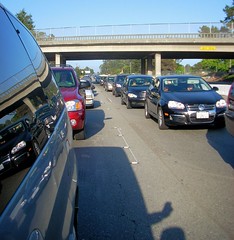I think everybody has heard that oil pushed through $90 a barrel on trading today. Let’s see what everybody has to say:
- A “cyclical downturn” for advertising and Internet businesses, including major players such as Google, Yahoo, and AOL.
- CNBC says the glass is half full.
- Robert Rapier is amused by traders’ herd instinct. Moo.
- Redstate.com wants to repeal the federal gas tax.
- You saw the news that Turkey is threatening to invade Iraq, right?
I’m sure that’s enough bad news for now, so I’ll conclude with this reminder that it’s spring in the antipodal regions of planet earth. Australia had it’s annual Bike to Work Day earlier this week, with many happy bike commuters enjoying the bicycle ride to work as thousands dusted off their bikes for the event. Treadly also posts a few entries on Bike To Work Day Down Under.
Now’s a good time to mention my buddy Jim in Fort Collins, Colorado. Jim is Oil Free and Happy and sells cute t-shirts and patches from his website for you to wear. I have one of his “Powered By Sweat” shirts. Oil Free and Happy — give him a visit and buy a patch or shirt from Jim. (I don’t make a dime from referring you to him.)
Photo: “NYC Bicycle Commuter 79th St @ 5th AVe” by Bicycles Only.

